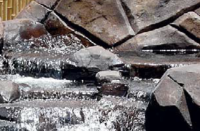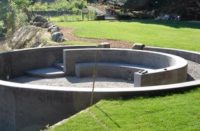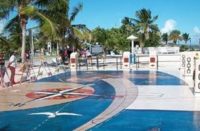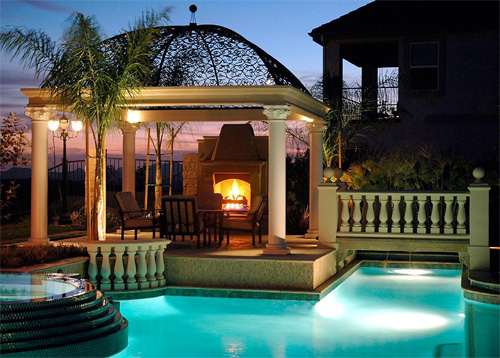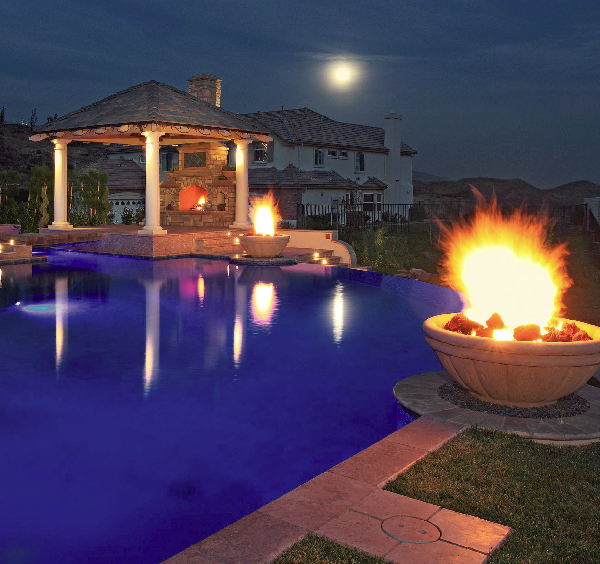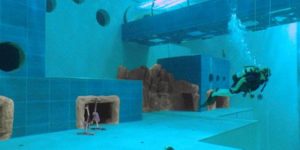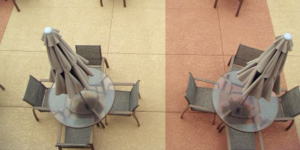People have enjoyed sitting outside around a fire since, well, since they discovered fire. Besides the practicalities of fire for warmth, light and cooking, the comfort and romance of fire make us want to pull our chairs up to the hearth and turn our backs on the daily grind.
So it’s no surprise that in the landscape design trend toward outdoor rooms, one of the most popular is the living room, anchored by the mass of a fireplace. Today’s patio furnishings, with their deep seating, ottomans and double loungers, are just about perfect for arranging in front of the fire.
Outdoor fireplaces are as individual as homeowners. They range from simple cast concrete or GFRC to fancy custom structures with decorative concrete hearths and surrounds. Budgets cover a wide range as well, from as little as $3,500 to 10 times that and more. But there are some common considerations and requirements for any fire feature, so before you jump on this bandwagon and decide to build fireplaces, there are some things you need to know.
Where does it go?
First, to decide where best to place a fireplace, you have to understand some design parameters. What do local building codes require? Is wood burning allowed or will the fireplace have to be gas? What are the requirements for setbacks from property lines and distances from buildings, decks or patio covers
Keep in mind that a fireplace is going to significantly change the view, so it needs to be placed where it can be a focal point, not an obstruction. In fact, fireplaces are great for dressing up a blank courtyard wall or creating privacy.
Weather matters. Besides hiding an undesirable view, a fireplace can be placed to help screen prevailing winds or breezes. Also consider traffic patterns.
How will people move from one area of the garden to another? The fireplace should be inviting, not in the way. Above all, people need to be able to walk past the fire safely. This concern is especially important when placing fire pits.
Next, what kind of fireplace do the homeowners want? Talk through how it is going to be used. Do they picture themselves next to the hearth, sipping wine and planning their next vacation? Or do they envision drinking beer with their buddies around the campfire? The answer to this question will inform the choice between a fireplace, fire pit or other fire feature.
For those who don’t want a vertical structure, fire pits are a great choice for the right style of patio. I like to build them into “conversation pits” with built-in seating and backrests, all out of concrete.
Try thinking beyond the pit. Fire in the garden is becoming more and more popular. Fire bowls or permanent gas-fed torches can be used to add lights throughout the yard. Natural gas is inexpensive to install and to use. Fire gives a softer, more natural-feeling light and ambiance than harsh electric bulbs.
Crafting the fireplace
A traditional fireplace is a firebox surrounded by a concrete or masonry structure. One of the big challenges is building it correctly so it can function as a fireplace. Size, temperature variations and air currents create different challenges for outdoor fireplaces than for indoor ones. The bottom line is, the chimney must draw the smoke.
Contractors are not always familiar with fireplace terminology. You need to do some research on words such as “draw,” “draft,” “flue,” “buoyancy,” “smoke shelf” and “spark arrestor.” Understanding the Rumford firebox — including the proper ratios between the fireplace opening, the chimney and flue — is key to delivering maximum heat with minimum smoke.
With these fundamentals firmly in place, you have lots of room for creativity in design. Almost any decorative concrete technique can be incorporated in a fireplace or combined with stacked stone, tile or brick.
For maximum impact, I like combining the two powerful opposing forces of fire and water. I often place fire features next to spas or illusion pools — flames just dance across the reflective surface of the water. One of my favorite fire/water combinations has water cascading 12 feet down a cut-stone wall behind an 8-foot fire trough. You hear the water splashing, see the flames rising and feel the warmth radiating from the crushed glass bed.
Whatever style is chosen, one important point I see often overlooked is that the interior of any masonry structure that contains fire must be protected with refractory brick. This brick is kiln-fired and can handle the heat.
I’ve seen fire pits built with cinder block and a gas ring. The aggregate gets too hot — it can explode and send superheated debris flying.
For the same reason, never use river rock in a fire pit or bowl. These rocks will explode. Lava rock has long been the industry standard for gas fire features. It is porous and allows a mix of gas and oxygen that creates a warm yellow flame. It retains heat for a warm glow, but withstands high temperatures without threat of exploding unless exposed to water. Water on hot lava rock creates steam that can make the rock crack or explode.
Near water features that might splash, I prefer to use crushed glass, which withstands heat and water safely. Crushed glass is available in various colors and gives a more contemporary look.
Fire features can be used as structures in outdoor rooms, garden lights or elements in a larger artistic installation. They can be traditional or contemporary, formal or casual. But even with all the talk about design trends and fashions, I believe the number one reason for the popularity of outdoor fires is that basic human longing to create … s’mores.
